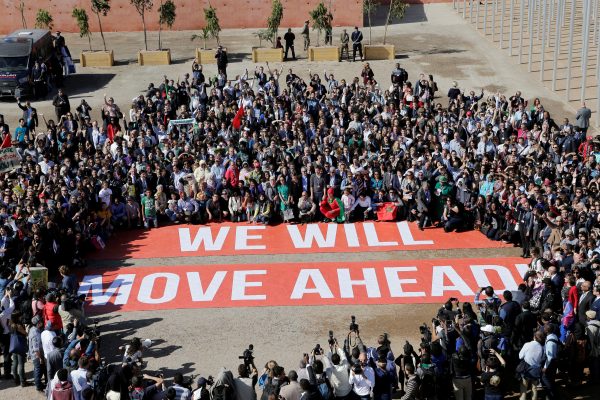, were shell-shocked as they came to terms with the election’s implications for global climate change. President-elect Trump has vowed to withdraw the United States from the Paris Agreement. While one country cannot cancel the agreement on their own, the absence of US leadership during the next few years will be enough to cause major headaches for the rest of the world.
The Paris Agreement is not the only climate change treaty to be signed in the past 12 months. Another major diplomatic achievement of the Obama administration occurred in October in Kigali, Rwanda. Nearly 200 countries signed on to an amendment to the Montreal Protocol, a 1987 treaty established to control gases that damage the earth’s ozone layer.
The Montreal Protocol forced the chemical industry to develop alternatives to the CFCs and HCFCs primarily used in refrigerators, air conditioners and as aerosols. Unfortunately, it turned out that the alternatives — HFCs (or hydrofluorocarbons) — were themselves potent greenhouse gases, trapping over 1000 times as much heat in the atmosphere as carbon dioxide.
To date, HFCs have only contributed a small amount to overall human-induced global warming. But their use has been growing at around 10–15 per cent per year, and estimates suggest that eliminating them could help avoid as much as 0.5 degrees Celsius of average warming.
Given the long and painful process of negotiation that the UN Framework Convention on Climate Change (UNFCCC) has undergone to reduce the use of carbon dioxide and other greenhouse gases, some saw the potential for a more effective solution to HFCs in simply amending the Montreal Protocol. The solution initially faced resistance from emerging economies such as China and India. The Montreal Protocol, while taking account of different stages of development, did not create the same developed–developing country divide enshrined in the UNFCCC.
In 2013, a breakthrough was made when President Obama and President Xi Jinping agreed to work to reduce HFCs through the Montreal Protocol. This agreement heralded a period of unprecedented engagement between the two countries on climate and clean energy. After China was on board, it was a matter of diplomatically manoeuvring the remaining emerging economies to engage with the agreement. It was finally signed on 15 October 2016.
The amendment set three separate timelines for countries at different stages of development. Rich countries, including the US, will need to reduce HFCs by 85 per cent by 2036. A second group, including China, have to achieve an 80 per cent reduction by 2045 (after peaking by 2024). The final group, including India, must reduce their HFCs by 85 per cent by 2047 (with a 2028 peak). This arrangement represented a concession to India, which was holding out for a better deal than that which China had already signed up to. But even India came to the party, surprising its counterparts by announcing an unconditional phase down of HFC-23 — the most potent of HFC gases — over the next 15 years. This would avoid an equivalent of about 100 million tons of carbon dioxide emissions over that period.
China’s HFC emissions have been increasing rapidly due to urbanisation and an ever-increasing demand for modern appliances. WRI predicted that in a business-as usual scenario, HFC emissions in 2030 could be almost four times the 2005 level. The Chinese government first set reduction targets for HFC emissions in the 12th Five-Year Plan, aiming for a cumulative reduction of 280 metric tonnes of carbon equivalent.
A key obstacle to the mitigation of HFCs in Asia is international standards. At least a third of China’s HFC production is related to products which are exported. The alternatives, such as hydrocarbons, are flammable and face tough restrictions imposed by independent industry associations.
Another factor is the high cost of alternatives. Some good alternatives to HFCs, including refrigerants such as hydrocarbons and hydrofluoroolefins, are not only better for the climate but are also more energy efficient. But their up-front cost is high, which has slowed their uptake, and further financial support will be required.
In 2015 the Chinese government introduced subsidies for reductions in HFC-23, which are expected to cut emissions of HFC-23 by close to 90 per cent by 2030.
While China’s existing subsidies could be expanded, there is also an opportunity to access finance through the country’s burgeoning carbon market. Inclusion of HFC reduction projects in carbon markets is controversial. In the past, HFC reductions received finance through the UN’s Clean Development Mechanism (CDM) program, until the EU restricted those credits in 2011. The funds from carbon credits made such a difference to the economics of HFC mitigation that Chinese companies were often found producing more HFCs than required, just so they could be paid to remove them.
While it is important to avoid such perverse incentives with appropriate safeguards, the inclusion of HFC reduction projects within the CCER offset programme (China’s version of the CDM), could hasten the phasing out of HFCs in China. Experts also point out that HFC reduction is easier to verify than other types of offsets, such as forestry and land use.
While there may be difficult times ahead in international climate change politics, the Kigali Amendment has already set the world on a path towards a rapid phase-out of HFCs. If it proves as successful as the Montreal Protocol was for CFCs, it will also be cost-effective. And this time Asia’s emerging economies are a proactive part of the process.
Huw Slater is Research and Projects Manager at the China Carbon Forum.

